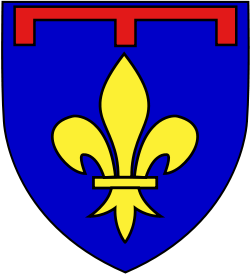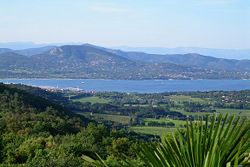Provence
Provence (Provençal Occitan: Provença in classical norm or Prouvènço in Mistralian norm) is a former Roman province and is now a region of southeastern France, located on the Mediterranean Sea adjacent to the Italian border. It is now part of the administrative région of Provence-Alpes-Côte d'Azur. The traditional region of Provence comprises the départements of Var, Vaucluse, and Bouches-du-Rhône in addition to parts of Alpes-de-Haute-Provence and Alpes-Maritimes. Provence is so named because it was one of the first Roman provinces outside of the Italian region.
History
Provence has been inhabited since ancient times. It was known in ancient times as part of Narbonensis, inhabited by Ligurians and later Celts. The coastal strip was settled by Greeks and Phoenicians from around 600 B.C.E. onwards, with Marseille (known by the Romans as Massilia) becoming one of the great trading cities of the Mediterranean. It was progressively settled by the Romans from the 2nd century B.C.E., eventually becoming a province of the Roman Empire. This gave it its name, from the Latin PROVINCIA (province), as Provence was one of the first areas conquered by Rome outside of Italy. Christianity arrived in Provence very early and the region was already extensively Christianised by the 3rd century AD, with numerous monasteries and churches being constructed. Provence fared badly in the aftermath of the fall of the Roman Empire, suffering repeated invasions: Visigoths in the 5th century, Franks in the 6th century and Arabs in the 8th century, as well as repeated raids by Berber pirates and slavers. It subsequently passed into hands of the Counts of Toulouse as a fief of the Counts of Barcelona (later Kings of Aragon).
In 973, Count William I defeated the Arab pirates based at Fraxinetum at the Battle of Tourtour and took the title Pater Patriae. From 1032 to 1246 the county was part of the Holy Roman Empire. It became a fief of the French Crown from 1246, under the rule of the Angevin dynasty. Upon the death of Charles du Maine in 1481, Provence was inherited by Louis XI. It was definitively incorporated into the French royal domain in 1486. Significant enclaves existed within Provence for many years afterwards: Orange remained under the control of the House of Orange-Nassau until 1672; the Comtat Venaissin, centered on Avignon, was under Papal rule until 1791; and Nice and Menton were not added to Provence until as late as 1860.
The now-extinct title of Count of Provence belonged to local families of Frankish origin, to the House of Barcelona, to the House of Anjou and to a cadet branch of the House of Valois.
Geography
Provence is bound by the Alps and Italy to the east and the Rhône River to the west, with the Mediterranean Sea providing its southern border. It has very varied topographical feautures, ranging from fertile plains in the Rhône valley to mountains in the east (notably Mont Ventoux, the Luberon range and the Alpilles), to marshlands in the south (the Camargue).
The Principality of Monaco is nestled between Nice and Italy. Marseilles, Aix-en-Provence, Avignon and Arles are other cities of importance in Provence. Marseilles is by far the largest city in Provence and the second or third largest city in France; the principal city of both the 'Bouches-du-Rhône' department and the region PACA (Provence Alpes Côte d'azur), Marseille is also called the chef-lieu (capital city) of Provence.
Climate
The climate of Provence is typically Mediterranean, warm and dry. However, the legendary Mistral is a strong, cold wind from the north that occurs mostly in the winter and spring. The higher regions of Provence get snow in winter. Temperature can be as high as 44°C.
The climate in Provence results from the combination of three factors:
- low annual daylight hours (up to 2900h, only 1600h in Dunkerque in the north of France)
- overwhelming precipitation (snow, rain, etc); in winter the wind called mistral/mistrau drives out the clouds after short but intense downpours.
- dreadful weather (the area could have dryness one month and rain the following, but still have significant dryness overall)
It rains only 330 to 350 days in the plain, but more in the Alps; by comparison, it rains more than 270 days in London. The annual average temperature on the coast is 15.1°C in Marseilles to 17.3°C in Menton, compared with 16.5°C in Barcelona, 18°C in Tunis, and 11.3°C in London. During the coldest month, the temperature in the day is from 11°C to 14.8°C on the coast (8°C in London).
Sights
Many remains from the Roman times can be seen in Provence, including:
- Arles, monuments listed as World Heritage Sites since 1981.
- Glanum, near Saint Rémy de Provence
- Orange
- Vaison-la-Romaine
Culture
Much rosé wine is produced under the Côtes de Provence appellation, using some of the typical grapes of southern France, Grenache, Syrah, Carignan, and Cinsault. It is often at its best young. The other Appelations of Provence are Bandol AOC, Les Baux de Provence AOC, Bellet AOC, Cassis AOC, Coteaux d'Aix-en-Provence AOC, Coteaux Varois AOC and Palette AOC.
Provençal is the adjective used to describe things originating from this region, as well as being the name of the local Occitan language under its regional variety, Provençal. Occitan is a Romance language that is part of the Romance dialect continuum that stretches from Italy to Portugal.
Authors who have written about Provence in Occitan include:
- Raimbaut de Vaqueiras
- Folquet de Marselha
- Bellaud de la Bellaudière
- Frédéric Mistral
- Robert Lafont
- Joseph d'Arbaud
- Théodore Aubanel
- Florian Vernet
- Francis Gag
- Max-Philippe Delavouët
- Claudi Barsotti
- Pierre Pessemesse
- Jòrgi Rebol
- Enric Espieut
Authors who have written about Provence in French include:
- Alphonse Daudet
- Emile Zola
- Henry James
- Jean Giono
- Marcel Pagnol
Authors who have written about Provence in English include:
- Peter Mayle/current resident
- Carol Drinkwater
Authors who have resided in Provence include:
- Henri Bosco
- Albert Camus
- Richard Perle
Painters of Provencal scenes and landscapes include:
Music written about Provence includes:
- The saxophone concerto Tableaux de Provence (Pictures of Provence) composed by Paule Maurice. Georges Bizet, 'L'Arlésienne'. Darius Milhaud, 'Suite Provençale'
On the culture of Provence see further: Prosper Mérimée, Notes de voyages, ed. Pierre-Marie Auzas (1971) Martin Garrett, 'Provence: a Cultural History' (2006) James Pope-Hennessy, Aspects of Provence (1988) Laura Raison (ed.), The South of France: an Anthology (1985)
See also
- Bullfighting
- Herbes de Provence
- List of dukes, kings, counts, and margraves of Provence
- Pastis
- Pétanque
- Provençal literature
- Ratatouille
- Saintes Maries de la Mer
- Saint Sarah
- Sisteron
- Santon (figurine)
- French wine
- Aix en Provence
External links
- Free pictures of Provence
- Official PACA Tourist Board Provence Alpes Cote d'Azur Tourist Board
- Areas of Provence Aix-en-Provence Tourist Office
- Art in Provence Contemporary artists of the region Provence Alpes Cote d'Azur shows their work.
- The Camargue Unique area in Provence: geography, history, economy, ecology, flora, fauna, towns, weather. Maps, photographs, weblinks.
- Provence for enthusiasts Provence: walking guide; classic yachts; villages; Roman remains; and in classic films.
Alsace • Aquitaine • Auvergne • Bourgogne • Bretagne • Centre • Champagne-Ardenne • Corsica • Franche-Comté • Île-de-France • Languedoc-Roussillon • Limousin • Lorraine • Midi-Pyrénées • Nord-Pas de Calais • Basse-Normandie • Haute-Normandie • Pays de la Loire • Picardie • Poitou-Charentes • Provence-Alpes-Côte d'Azur • Rhône-Alpes
Overseas regions: French Guiana • Guadeloupe • Martinique • Réunion
af:Provence an:Probenza frp:Provence zh-min-nan:Provence ca:Provença cy:Provence da:Provence de:Provence es:Provenza eo:Provenco fr:Provence gl:Provenza ko:프루벤소 it:Provenza he:פרובאנס ka:პროვანსი nl:Provence (Frankrijk) ja:プロヴァンス oc:Provença nds:Provence pl:Prowansja pt:Provença ro:Provence ru:Прованс scn:Pruvenza sr:Прованса fi:Provence sv:Provence zh:普罗旺斯
Credits
New World Encyclopedia writers and editors rewrote and completed the Wikipedia article in accordance with New World Encyclopedia standards. This article abides by terms of the Creative Commons CC-by-sa 3.0 License (CC-by-sa), which may be used and disseminated with proper attribution. Credit is due under the terms of this license that can reference both the New World Encyclopedia contributors and the selfless volunteer contributors of the Wikimedia Foundation. To cite this article click here for a list of acceptable citing formats.The history of earlier contributions by wikipedians is accessible to researchers here:
The history of this article since it was imported to New World Encyclopedia:
Note: Some restrictions may apply to use of individual images which are separately licensed.


